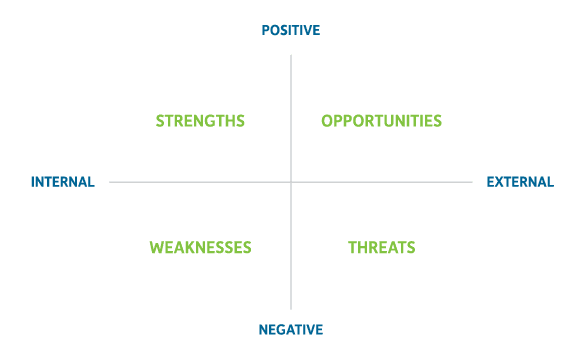No matter the size of your organization or how established it is, a company SWOT analysis is a highly valuable tool for developing your business strategy and prioritizing business activities and resources.
But if you’ve heard businesspeople throwing around the term SWOT and you have no idea what the heck it means, don’t worry – you’re not alone.
And don’t be intimidated. A company SWOT analysis might sound complex, but it’s just an acronym for a very simple exercise that won’t cost you anything except a few hours of your time and some thoughtful consideration.
SWOT stands for:
Strengths
Weaknesses
Opportunities
Threats
So how do you do a company SWOT analysis?
The quadrants
To start, you’ll need to create a square that looks like the one below, in which strengths, weaknesses, opportunities and threats are divided into four quadrants.
You can use any media you prefer, such as:
- A large piece of paper affixed to a board or easel
- A dry erase board
- Projection from your computer onto a blank wall or screen
- Collaborative platform with shared access, such as a Google document
Whatever you opt to use, the point is that the image is visible and accessible for everyone in a group setting – whether in person or online – and provides ample space to add notes.

Now let’s explore the best approach to fill each quadrant.
Internal factors
This is what’s happening inside your company – the things that you exercise some control over and can change with the appropriate strategy and effort.
Strengths
Ask the group: What are we doing currently that is making our company successful? What do we want to continue doing – and perhaps emphasize more? What makes a customer choose us over competitor?
Examples of strengths:
- Education, specialized knowledge and skill sets within your team
- Access to certain technologies
- Intellectual property or patents
- Efficient, proven-successful business processes
- Effective business strategy
- Good location
- Positive workplace culture
- High employee retention
Weaknesses
What do we need to change, improve or stop doing? What internal threats put our future at risk?
Examples of weaknesses:
- Inefficient business processes
- Outdated or insufficient technology
- Knowledge or skill gaps within your team
- Lack of business acumen within your team
- Ineffective organizational structure
- Negative workplace culture
- High employee turnover
- Dependency on too few key employees – what if they suddenly were no longer available?
- Poor accounting or financial practices
- Undesirable location
- Neglecting of certain business functions
- Internal cybersecurity issues
External factors
These are things that originate outside your company. Unfortunately, you have minimal – if any – control over these factors. But you can plan ahead and be prepared – even for the unexpected.
Opportunities
What can you capitalize on to potentially gain market share or boost profits? What circumstances can you leverage to your competitive advantage?
Examples of opportunities:
- Economic or market trends in your favor
- Opening of new markets
- Potential to acquire a competitor
- Competitor shutting down or scaling back operations
- Outstanding reputation among customers and industry partners
- Laws or regulations that positively impact your company
- New technologies that make your work easier and processes more efficient
- Favorable labor market
- Upcoming events that provide the ideal venue for networking and spreading awareness of your business
Threats
What are the environmental factors that could cause our business operations or project to suffer? What do we need to be prepared for, in terms of having a mitigation plan?
Examples of threats:
- Economic or market trends not in your favor, including price shifts and industry-wide downturns
- Unfavorable labor market
- New technologies that upend the market and change how you do business – possibly even replacing your product or service
- Changes in consumer preferences
- Loss of customer or industry partner
- Supplier shortages
- Laws or regulations that negatively impact the company
- New competitors flooding the market, coming out with a product or service that is very similar to yours
- A competitor poaching your employees
- External cybersecurity issues
- Natural disasters and the resulting damage to your workplace, loss of productivity, interruption of business activity and displacement of employees
How a company SWOT analysis works
A company SWOT analysis is really just a large brainstorming session. Not so complicated, right?
Much of how this process plays out and how many rounds of brainstorming it takes is up to you and your company’s working style.
It could take place in person or online.
And the length is open ended, though it shouldn’t take more than a few hours. Focus more on productivity and the quality of ideas.
Generally, this is what happens:
- Participants share ideas on your organization’s strengths, weaknesses, opportunities and threats – either by first writing down their ideas individually or calling them out in a more collaborative way.
- These ideas are placed in the appropriate quadrant.
- Some ideas are merged with other, similar ideas; eliminated; or even shifted into different quadrants as necessary.
At the end of the session, you should have a complete, agreed-upon list of strengths, weaknesses, opportunities and threats in the designated quadrants.
A few additional tips:
- Establishing ground rules can be helpful to guide the discussion and set parameters.
- Avoid criticizing ideas. You want to foster an open, accepting environment in which people feel comfortable speaking up. After all, you don’t want to miss out on a good idea because no one wanted to share. Instead, when ideas are discarded, remain objective and explain why the idea doesn’t work. Focus on the idea – don’t make it personal.
- Make sure that ideas are placed in the correct quadrant. Try not to confuse weaknesses with threats, and strengths with opportunities – or vice versa.
- Don’t focus only on the negative. People tend to take their company’s strengths for granted and feel like these don’t need to be listed – but they absolutely do.
When should it happen?
It depends on the goal of this exercise. Some examples are:
- Examine a new idea or a project
- Kick start annual business planning
- Basis for a marketing plan
- Regular review and evaluation of how the business is doing
If you would like to examine a new idea or project, this is one-time exercise. If it is business plan, then your company SWOT analysis should happen on a regular basis – ideally, at least once per year.
SWOT analysis isn’t intended to help you respond immediately to situations. It focuses on mid- to long-term strategies.
Who should participate?
Leadership at all levels of your organization, from the founders and C-suite down to managers of individual departments, can be involved in your company SWOT analysis.
Ideally, the most senior leadership manages the activity and has the final word on the SWOT list, because they’re responsible for guiding your company and have the most expansive view of the entire organization.
Who else should be involved? Anyone with a perspective of your company that could be relevant.
This may include:
- Key players across every internal business function
- All employees – to source ideas and truly involve them in shaping the future of the company
- Certain customers or industry partners (ex., vendors or suppliers) with whom you feel comfortable or enjoy a long-term relationship
- Providers of professional services for your organization, such as your accountant or a professional employer organization (PEO) that helps to manage your HR functions
Be creative and strategic in selecting attendees.
You want to capture the most accurate, comprehensive view of your organization.
Someone with a differing perspective or opinion from yours – even a trusted voice outside your organization – can think of strengths, weaknesses, opportunities and threats that you may have otherwise overlooked entirely. They can also persuade you to change your opinion and approach an issue differently.
What do you do with this information?
As mentioned previously, a company SWOT analysis is an exercise that aids in annual planning and strategy development, and prioritization of business activities and resources.
This isn’t something that is typically shared throughout an organization in its raw form. Instead, the themes produced in the SWOT analysis inform and are weaved into:
- Overall business strategy
- Department goals and objectives
- Individual employee goals and objectives
- Change management plans
- Marketing and sales plans
- Legal strategy
- Hiring and training initiatives
Benefits of performing a company SWOT analysis
A SWOT analysis has been used by corporations and small business since the ’80s and is still a relevant and practical tool. If you haven’t used it before, give it a try. You might be amazed by the results produced by this simple exercise.
- It can deliver a 360-degree view of your organization’s status. You’ll gain valuable insights into your position and understand exactly where you stand.
- You can pause and take all factors under consideration, and select your priorities moving forward. You can envision a roadmap for the future.
- You’ll get an idea of what your employees, customers, partners and even competitors think about your company and its operations.
- You’ll gain an opportunity to plan for what could happen – positive or negative – to minimize surprises.
- You can discuss what could be done better in the past and strategize how to improve.
Summing it all up
When done right, SWOT analysis will help you visualize what you’re doing well, what you need to change and which scenarios you need to look out for – the situations you can leverage to your advantage and the situations you need to safeguard your company against.
Armed with this intelligence, you can prioritize and take the most optimal steps to assure your company’s success.
For more information on planning for business scenarios and preparing your organization for the future, download our free magazine: The Insperity guide to managing change.


